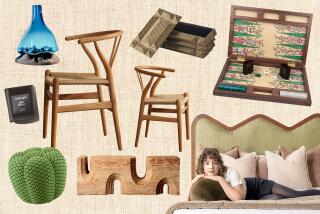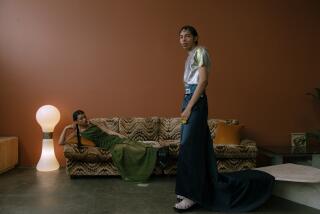Fresh off the page
THE first CB2 catalog arrived recently with a cover full of colored circles, a “Twister” mat of housewares. CB2 is “a new destination from Crate & Barrel” -- though only a geographic destination if you live near Chicago. For the rest of us, it’s just 67 glossy pages of minimalist furniture that makes me feel the need to dust.
The name emphasizes its heritage, but CB2 is positioning itself as more affordable without suggesting that its parent company has become overpriced. So it calls its designs “minimal that’s more livable.”
I came across www.CB2.com on the design blog Apartment Therapy in 2004 while I was fumbling for an elegant way out of the futon-sofa bed quandary. The then-new website prominently featured the Flip Flop Convertible Sofa, which I found unexpectedly compelling. It was, like all their products, photographed on a seamless backdrop, an orange mattress with metal legs floating in space.
It was also too deep for my office-guestroom. But like many CB2 online shoppers, who are called “fans” in the catalog’s magazine-style introduction, I was eager to see how these floating pieces would land in the context of a room.
In the catalog, each item is described in retail haiku that makes for entertaining dramatic recitation: “bubble screen. the great divide. Rorschach debate. Some see open diamonds. Others squares.” The prose is often more dramatic than the wares. Despite the bold cover, the tableaux inside are muted to the point of looking like waiting rooms. Tans and chocolates and taupes and the occasional sage. There’s a bottle of Sapphire gin on one coffee table, as if even the set dresser was trying to liven up this party. The office furniture is all silver powder-coated (shades of IKEA) and referred to in one blurb as “mechanic-shop chic.” Oh, dear.
CB2, which opened the first of two Chicago stores in 2000, is not without allure. But in print, as online, it still feels like a collection of objects, not yet, to use CB2 lingo, a complete destination.
I wonder if it’s any coincidence that the same week CB2 debuted in paper, another West Elm Spring ’06 catalog arrived. Of course, West Elm mails out 12 catalogs a year, so I guess the chances were good.
Like CB2, West Elm is a retail spinoff, this time from Williams-Sonoma. Each is the value brand of its respective retail family, targeting a similar design- and price-conscious consumer. Their catalogs have much in common: geometric platform beds, decorative bamboo bundles, upholstered ottoman cubes. But with West Elm, the throw pillow has fallen farther from the sofa.
Pottery Barn, another Williams-Sonoma brand, always has had a sense of cultivated casualness to its catalog that I think of as aspiring Cape Cod. West Elm feels more urban, perhaps why I am more at home in its pages. In this issue, the furnishings appear to have been photographed in real houses -- real houses with functional windows that reveal sunlight and greenery. It is a visual relief after exiting the airless CB2 universe.
Compare the dining room diorama in each. CB2’s has black leather chairs with steel-tube legs at a blond wood table. The carpet is charcoal; the walls blue. The table is set for one, a lonely dieter, apparently, who is eating a dish of melon balls. The West Elm dining room has floor-to-ceiling factory windows that open onto a yard with a large palm tree. Around the blocky wood table are butter-tone upholstered chairs. And being served? White wine, already poured in two glasses, and a heap of artisan bread and cheese.
West Elm started its retail existence as a catalog in April 2002. Westelm.com and a store in Brooklyn followed the next year. It now has 12 stores, including one on 4th Street in Santa Monica. To my memory, the furnishings haven’t changed radically.
There’s plenty of chocolate and espresso stain in the land of West Elm, but there’s a splash more color too. The simply styled furniture is complemented by Moorish-influenced rugs or pillow shams described as generically “ethnic.”
One of the details I always notice in catalogs is what they’ve chosen to display on the bookshelves. In West Elm’s home office, it’s an assembly of vintage Penguin classic paperbacks. In CB2, Dwell peeks out from a magazine holder in a living room. At least we know where CB2 has set its sights.
Robin Rauzi can be reached at [email protected].


